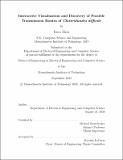Interactive visualization and discovery of possible transmission routes of Clostridioides difficile
Author(s)
Zhou, Erica,M. Eng.(Massachusetts Institute of Technology)
Download1227276694-MIT.pdf (8.164Mb)
Other Contributors
Massachusetts Institute of Technology. Department of Electrical Engineering and Computer Science.
Advisor
Michael Stonebraker.
Terms of use
Metadata
Show full item recordAbstract
In the medical setting, prevention of healthcare-acquired infections (HAIs) is an important area of research in order to mitigate extraneous complications and medical costs. In the United States alone, infections caused by the Clostridioides difficile (C. difi) bacteria affect up to 500,000 hospital patients annually and can have serious, even fatal, consequences. C. difi can spread person to person through direct contact as well as indirect contact through infected surfaces, equipment, or people. However, through current means, it is difficult to quantify exactly how infection is transmitted and, consequently, how to best manage and combat it. Using Kyrix, a pan-and-zoom data visualization platform, we propose an interactive visualization system to depict connections between hospital patients that may be used to identify possible routes of transmission such as shared hospital rooms, reusable medical equipment, and common providers. By taking advantage of the "zoom" functionality, users can access the data at various levels of specificity, starting with a 3D overview of the hospital, zooming into specific floors or rooms of interest, learning about individual patient cases, and finally honing in on a specific patient and their connections with other patients. With such a system, hospital epidemiologists can quickly and easily identify interactions that may represent opportunities for person to person transmission and focus their efforts, investigations, and interventions accordingly.
Description
Thesis: M. Eng., Massachusetts Institute of Technology, Department of Electrical Engineering and Computer Science, September, 2020 Cataloged from student-submitted PDF of thesis. Includes bibliographical references (pages 71-73).
Date issued
2020Department
Massachusetts Institute of Technology. Department of Electrical Engineering and Computer SciencePublisher
Massachusetts Institute of Technology
Keywords
Electrical Engineering and Computer Science.